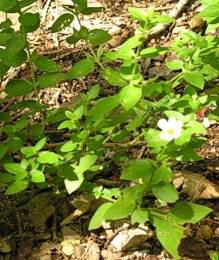Barleria scindens
Barleria scindens Oberm.
Family: Acanthaceae
Common names: none recorded
Introduction
Barleria scindens, not a very well known species in the genus, produces beautiful mauve flowers from February to July. It is ideal for sunny areas in the garden.

Description
Description
Barleria scindens is a herbaceous, evergreen, fast-growing, much-branched ground cover, up to 350 mm high. The leaves are egg-shaped (ovate-lanceolate), hairy, dark green above and slightly paler underneath. The funnel-shaped flower is divided into 2 lips or flower parts; the upper lip is divided into 4 lobes. The bottom lobe is single. The stamens (pollen producing structures in a flower) are situated in the lower quarter of the flower tube. The flowers are borne in 1- to 2-flowered clusters in the axils (angle between the stem axis and leaf stem) and the bracteoles (reduced leaves) are toothed.

Distribution and habitat
Distribution description
Barleria scindens is a tropical African species and was thought to occur naturally only in Zimbabwe, but on one of my many collecting trips to the Limpopo Province, I collected two specimens, one at Wyllie's Poort in the Soutpansberg and the other at Punda Maria in the Kruger National Park that looked similar to the description by Obermeyer (1931).
It grows in well-drained soils on rocky outcrops and hillsides in full sun to semi-shady spots. It is able to withstand a moderate amount of frost. Rainfall ranges from 500-800 mm per annum with temperatures above 30°C.
Derivation of name and historical aspects
History
Barleria scindens was collected for the first time by F.A. Rogers near Bulawayo in Zimbabwe. The specific epithet scindens means splitting or dividing explosively, referring to the opening process of the seed capsule. The genus Barleria is a group of herbs and shrubs with 250 species worldwide, some producing spines and all producing fruit in the form of explosive capsules. It is found throughout the warmer parts of Asia, Africa and America.
Ecology
Ecology
Barleria scindens is pollinated by insects and attracts various species of butterflies. Therefore this plant is a good choice for attracting bird and insect life into the garden.
The fruit is a small capsule which explodes to release the seed.
Uses
Use
Barleria scindens is a good plant for the water-wise garden.

Growing Barleria scindens
Grow
Barleria scindens can be propagated from seed or from cuttings. It grows easily from seed. Collect the fruit as soon as it turns brown, otherwise the capsules explode and the seeds are lost. Sow the seeds on the surface of a good soil, compost and sand mix in a ratio of 2:1:1, pressing them slightly into the surface. Place in 40 % shade and water once a week with a fine sprinkler. Germination takes place after a week or two. Seedlings should be transplanted when they are about 200 mm high.
Take cuttings from partially matured wood, 60 mm long, dip the bottom part of the cutting into hormone powder and plant the cuttings in a mixture of soil, compost and river sand in a ratio of 3:2:1. The ideal temperature for optimal root development is 15-28ºC. Keep the cuttings in a shady spot and water twice a week.
The plants require full sun to semi-shade and should be planted in sandy to loamy soils. Mix 500 g of compost with 50 g of superphosphate, working it into the soil to improve the growth of the plants. A moderate amount of water is required and these plants do rather well in the dry season, thus a perfect choice for a water-wise garden and the rehabilitation of disturbed areas. The growing tempo is fast and they need to be pruned back after the flowering season.
No known pests or diseases are encountered.
References
- Lewis, C.T. & Short, C. 1879. A Latin dictionary. [founded on Andrews' edition of Freund's Latin dictionary revised, enlarged and in great part rewritten]. Claredon Press, Oxford. Reprint 1980.
- Obermeyer, A.A. 1931. A revision of the South African species of Barleria. Annals of the Transvaal Museum 16,11.
Credits
Willem Froneman
Lowveld National Botanical Garden
September 2009
Plant Attributes:
Plant Type: Ground Cover, Perennial
SA Distribution: Limpopo
Soil type:
Flowering season: Late Summer, Autumn
PH: Neutral
Flower colour: Mauve/Lilac
Aspect: Full Sun, Morning Sun (Semi Shade), Afternoon Sun (Semi Shade)
Gardening skill:
Special Features:
Horticultural zones








Rate this article
Article well written and informative
Rate this plant
Is this an interesting plant?
Login to add your Comment
Back to topNot registered yet? Click here to register.